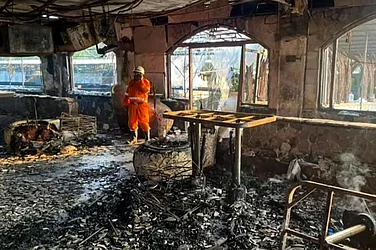In 1947, Kurt Gödel, then at Princeton, raised a serious question about the US constitution. The 20th century’s greatest logician, for whom Albert Einstein said that he went to his office “just to have the privilege of walking home with Kurt Gödel”, claimed to have found a logical inconsistency in the constitution that could nullify its various provisions. It’s still a mystery what perturbed the genius, but 75 years later, the holy text of the Indian Republic is also faced with some questions, with a sitting chief minister even demanding a “complete review” of the Constitution.
Indian federalism is under strain on several fronts—constitutional, economic, political and electoral—to the extent that Opposition chief ministers have invented the phrase “combative federalism”. The Union government is locked in an unsavoury confrontation with several states; the mutual disdain regularly invites distasteful remarks. Several states complain of being bullied by the Centre, as the electoral process is bulldozed by the BJP’s powerful machinery. It can buy maximum advertisement space in the media; its top leaders can get their interviews telecast on the day of voting, and electoral bonds help the party bag mammoth donations that undermine the electoral process and democracy.
A report by the Association for Democratic Reforms found that in 2019-20, the BJP had received Rs 2,642.63 crore from “unknown sources”, 78.2 per cent of the total receipts of seven national parties. Riding on finances, the BJP easily forms governments in states, despite losing the elections and having fewer numbers. This has created such distrust that almost every move by the Union government invites an accusation. Tamil Nadu chief minister M.K. Stalin recently opposed the “one-nation-one-registration” proposal made by Union finance minister Nirmala Sitharaman in her budget speech. Several states fear a loss to their exchequer as land registration fee is a major source of their revenue. “Federalism is under threat today as the BJP-led government is divesting all powers of the states,” Stalin said.
“The BJP government is constantly trying to weaken the federal structure. They brought the GST, but they are not following it in spirit, not giving us our share,” Chhattisgarh Chief Minister Bhupesh Baghel tells Outlook.
ALSO READ: Federalism And The Idea Of Regionalism

He notes that “the grant ratio for the schemes run by previous central governments was 90:10 or 75:25. Sometimes there was a 100 per cent grant as well”. “But now they give us only 50 per cent. States are forced to fund the central schemes for which they take credit. How would we fund our schemes?” Baghel asks.
The concentration of political power has also brought back the economic centralisation of previous eras. In 2019, former RBI governor Raghuram Rajan wrote that all “ideas and plans emanate from a small set of personalities around the prime minister and in the Prime Minister’s Office”, a tendency that doesn’t work well “for economic reforms”.
But the BJP dismisses these concerns. “The federal structure was attacked during Congress’s rule. The amount of tax revenue that states are now receiving is more than they ever did. This is a glorious period for federalism,” party spokesperson Shahnawaz Hussain tells Outlook.
He argues that “not all state governments” have complaints against the Centre. “Some state governments will only make negative comments. Whatever we do, Mamata Banerjee will find it problematic. Kerala is ruled by Communists, but we don’t receive many complaints from them.” Hussain named Captain Amarinder Singh, Ashok Gehlot, Jagan Mohan Reddy among CMs who had few complaints.
***
Indian politics can be divided into three broad phases: a dominant Centre, first under Jawaharlal Nehru and then under Indira Gandhi and Rajiv Gandhi (1947-1989)—except for a brief period during the Janta Party tenure in the 1970s; reign of regional parties and coalition governments (1989-2014); and the Narendra Modi era (2014-present). While the initial phase of Modi’s tenure didn’t see any major confrontation with states, his second term began with the dismantling of Jammu and Kashmir in August 2019. It was the first instance when a state was downgraded to a Union Territory, without any recommendation by its legislature or consultation with residents. Worse, it happened when the state was under President’s Rule and had no elected government. The Centre first administered anaesthesia to the state, and then amputated its limbs.
But Hussain claims it was the “people’s demand”. “People wanted to get rid of the two families. No one is angry except the Abdullah and the Mufti families. Ninety per cent of the people have supported it.”
When he was the Gujarat chief minister, Modi often attacked the UPA for “destroying the federal structure for their self-interests”. “Federal structure is at the heart of our nation’s democracy, but UPA is adamant on destroying it for their vested interests,” he tweeted on March 4, 2012.
ALSO READ: Renegotiating India’s Federal Compact
Former MP and chairman of the Congress’s research department, Rajeev Gowda, notes that “Prime Minister Modi popularised the phrase ‘cooperative federalism’, but his track record has been the exact opposite.”

“Under the GST regime, states gave up their capacity to tax in different domains, in return for a compensation arrangement from the central government for the first five years. But last year, when the states were on the frontlines fighting against the pandemic, the Centre did not release the money due,” Gowda says. “When Opposition leaders raised the issue, finance minister Nirmala Sitharaman said they can borrow from the market. The Centre reneged on the original commitment.”
Several institutions also seem to be facilitating the political goals of the Centre. The most disturbing signs emanate from the judiciary. A day after UP minister Swami Prasad Maurya left the BJP in January, a court issued an arrest warrant against him in an old case. Some two dozen petitions are pending in the apex court, challenging the dismantling of J&K and nullification of Article 370. Yet, the court has not given an urgent hearing to a case that strikes at the core of federalism.
Autonomous research and academic institutions also act as a hedge against a unitarian centre. As these institutions engage with various forms of learning and celebrate diverse cultures, the idea of a monolithic centre gets contested. But when the Union government takes over these institutions and imposes a singular thought, federal truth gets diluted. Perhaps, the most consequential assault in recent years is through the Hindutva identity that delegitimises dissidents and divergent groups.
The ED and the CBI were never known to be impartial, but every veneer of constitutional propriety is off now. Last November, the Centre promulgated two ordinances allowing extension of the tenures of CBI and ED directors from two years to up to five years. The ordinance overruled the SC order of September 2021 that said extension of tenure of officers after retirement should be done in rare and exceptional cases.
A fixed tenure for the CBI and ED directors dilutes the criminal justice system. Sanjay Mishra, who is supervising several cases of money laundering against Opposition leaders, was appointed the ED director for two years in November 2018, but managed to get successive extensions.
“Cases are constantly being taken away from the state police and transferred to the CBI and NIA, including sensitive cases like the Elgar Parishad. The Centre’s focus is not on solving these cases, but in politicising them,” Gowda says.
In the proposed amendments to the Indian Administrative Service (Rules), several states found yet another violation of their rights. At present, the state can reject the Centre’s request to send an officer on deputation, but the proposed amendments give the Centre overriding powers. Nearly a dozen states have already opposed the proposal.
Add to this the variety of laws passed by the Union government that fall in the State List, including the farm laws that were eventually withdrawn. “The newly established Union ministry of co-operation deals with cooperatives, a subject that is in the State List. The intent is clear: how to take over the politically and economically powerful space of cooperatives,” says Gowda.
***
But is it unique to the Narendra Modi government or is there an inherent element in the Indian political-bureaucratic system that organically enables a centralised authority? Chhattisgarh’s former CM Ajit Jogi once told me that there are three power centres in India—DM, CM and PM. Jogi was perhaps the only person who occupied a bungalow as the city’s district magistrate, and when Raipur became Chhattisgarh’s capital, came to occupy the same premises as the chief minister.
These three positions carry an authority that, in the absence of efficient checks, becomes invincible. Several chief ministers, who oppose the PM’s authority and justly so, often run their states like a personal fiefdom. Modi’s dominance can, then, be attributed to his hypnotic electoral majority, and his political performance a function of his voter’s expectations. As a leader who knows that his voter celebrates him for the command he displays, he must ensure absolute allegiance from all, and even get his photograph on the vaccine certificate.
In his essay Shooting An Elephant, George Orwell describes an incident when he, as an imperial police officer posted in what was then Burma, was forced to kill the harmless animal because people wanted him to. He found that he was an “absurd puppet pushed to and fro” by the people around him, “a hollow, posing dummy”, who was destroying his “own freedom”. “He wears a mask, and his face grows to fit it.”

It can be safely assumed that our leader knows when the face and the mask become indistinguishable, that a cult becomes formidable when even a municipal election is contested in his name and everybody else becomes irrelevant. An unknown MLA can be made the Gujarat CM, Uttarakhand CMs can be removed at will and Union ministers can be kept at the mercy of the leader.
“When a leader in a democracy becomes a cult, the first casualty is the exchange of views within their party. They don’t wish to hear any alternative voice, leave aside those that are antithetical to his views. The cult figure wants allegiance from institutions that are required to promote democracy,” Rashtriya Janata Dal spokesperson Manoj Kumar Jha tells Outlook.
Since authoritarian politics is infectious and few leaders may be willing to surrender their privileges, the example set by the present government may become the template for future governments. “If the cult phenomenon gets normalised, the next government would also like to follow it. The Constitution will become meaningless,” says Jha.
Deliberating over the inconsistency Gödel found in the constitution, a US jurist suspected that perhaps the logician thought that Article V, which lends almost unlimited power to amend the Constitution, may lead to the complete nullification of the charter itself. In the Indian context, the devil perhaps lies in electoral majority. The majority that is imperative for the smooth functioning of parliamentary democracy can also lead to a majoritarian rule.
Federalism is not a mere constitutional principle. A natural choice to accommodate and salute diversity, it signifies the co-existence of diverse, even conflicting perspectives. The Constituent Assembly had vigorous debates on the nature of the Constitution, with B.R. Ambedkar insisting that it was “a federal Constitution” and the states were not “agencies of the Union”.
Eventually, these are the electoral compulsions that defeat the authority. Exhibit A is the repealing of the farm laws ahead of the assembly elections in Uttar Pradesh and Punjab. The biggest surrender by the Union government in the last seven years came against a movement that didn’t wear the flag of any political party. When the Opposition mostly consumes itself on hashtags and doesn’t sufficiently challenge the dominant party, when hallowed institutions succumb, masses carry the torch. One can call it people’s federalism, a mechanism that India needs now.
(This appeared in the print edition as "Centripetal Vortex")


























